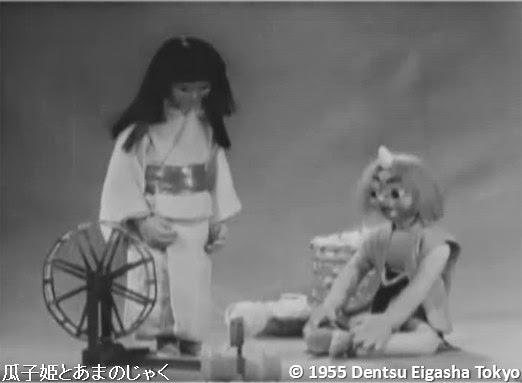Uri no Hime and the Contrary Person: A Combination of Charming Characters and Deep Story

The Melon Princess and the Contrary Person - Urikohime to Amanojaku■ Public Mediatheater ■ Original MediaAnime Original ■ Release dateJanuary 1956 ■Distribution companyEducational film distributor ■Frequencies18 min ■ Number of EpisodesEpisode 1 ■ DirectorTadanori Mochinaga and Yoshitsugu Tanaka ■ ProductionEducational Film Company Dentsu Film Company Puppet Film Studio Kiichi Inamura ■ Story Long ago, when picking up a sack that had floated down the river, an adorable girl was found inside. The old man and woman named her Urizuhime and raised her with love. When Urizuhime sang while weaving, the villagers, rabbits, and even the birds were captivated by her songs. Only Contrary, a hated little imp living in the village, opposed Urizuhime in every way. While they were away, the sack messed up the loom threads, but Urizuhime didn't get angry and muttered that she should be well behaved. Contrary, listening from the roof, yelled that she would never be well behaved. However, afterwards, she gazed at the moon alone in loneliness. There was a greedy rich man in the village who had his eye on Urizuhime's textiles. The rich man persuaded Contrary to come up with a plan to kidnap the princess. The Contrary Man sneaks into the Princess' house, but instead the Princess treats him kindly and he starts helping her with the thread-spooling. He sheds tears of joy when the Princess asks him to be friends with her. The Frustrated Rich Man kidnaps the Princess and runs away, but the Contrary Man and the rabbits rush to get her back. With everyone's help, the Rich Man escapes and the Princess is safely rescued. After that, the Contrary Man becomes an obedient boy and starts working in harmony with the villagers. ■Explanation Conventional puppet films were either manipulating puppets with strings or using the Guignol method, and there were few one-shot puppet animations, but Mochinaga Tadahito, who shot his puppets in China, produced what could be called Japan's first full-scale one-shot puppet animation. As it was the first film, the movements were said to be flat, but it is unfair to compare it to the Czech Republic, where the history, experience, and production funds are different. However, Nihon Iku is also a commemorative work that marked the birth of a full-scale puppet film (I would like to distinguish "puppet films" from films that are not one-shot, such as those using strings). ■ Main staff・Planning/Ningyo Eiga Seisakusho ・Screenplay/Kiji Tanaka ・Cinematography/Jiro Kishi ・Music/Yoshitaka Sakamoto (Japanese Animation Film History p.248 not mentioned) A detailed review and recommendation of Uri-kohime to Amanojaku■ Background and historical significance of the workReleased in 1956, "The Contrary Girl and the Melon Princess" occupies an important place in the history of Japanese animation films. This work is a memorable one in which director Mochinaga Tadahito utilized the experience he had gained in China to produce Japan's first full-scale one-shot puppet animation. At the time in Japan, puppet films were mainly made using string puppets or the Guignol method, which involved manual manipulation, and one-shot puppet animation was extremely rare, so this work is regarded as a pioneer of a new method of expression. It is also worth noting that this work was produced through the cooperation of several production companies, including Kyoiku Eigasha, Dentsu Eigasha, Ningyo Eiga Seisakusho, and Kiichi Inamura. Each company took on a new challenge, making use of their own expertise. In particular, director Tadahito Mochinaga's experience in China had a major influence, and without his skills and passion this work would not have been made. ■ Story appeal and character analysisThe story of "Urikohime and the Contrary Person" is based on a classic folktale and depicts the growth and change of two characters, Urikohime and the Contrary Person. Urikohime is a cute girl who appears from inside a melon that floats down the river, and her singing voice charms the villagers and animals. Meanwhile, the Contrary Person is disliked by the village, and although he initially resents Urikohime, he gradually opens up to her. The character of Urikohime symbolizes purity and kindness, and her singing voice and weaving skills are important factors in maintaining peace in the village. Her presence brings hope and joy to the villagers, brightening the whole story. Meanwhile, Contrary Man starts out rebellious and self-centered, but gradually changes as he is touched by Urikohime's kindness. His growth plays an important role in depicting the importance of human relationships and changes of heart. The greedy rich man who appears in the story is a villain who has his eye on Urizuhime's textiles and tries to kidnap her. His presence adds tension and drama to the story, and plays an important role in testing the bond between Urizuhime and the contrarian. In the end, with the help of the villagers and animals, Urizuhime is rescued, emphasizing the power of community and the value of friendship. ■ Technical evaluation and production difficulties"Urikohime and the Contrary Person" was produced using a new technique called one-shot puppet animation. This technique differs from the traditional string or hand-operated Guignol method in that it allows for more realistic movement and facial expressions. However, one-shot animation requires a great deal of time and effort, making it highly difficult to produce. In particular, director Tadanao Mochinaga had to adapt to the Japanese production environment while making use of his experience in China. Due to the difference in production funds and technology between Japan and the Czech Republic, and because it was the first film, it has been criticized for being flat, but it can still be said that this work has written a new page in the history of Japanese animation films. The contributions of cinematographer Jiro Kishimoto and composer Yoshitaka Sakamoto were also significant. Jiro Kishimoto's cinematography captured the movements of the puppets more realistically, and Yoshitaka Sakamoto's music played an important role in enhancing the atmosphere of the story. Without the cooperation of these staff members, this work would not have been completed. ■Recommendations and viewing points"Urikohime and the Contrary Person" is an essential work for understanding the history of Japanese animation films, and is highly recommended for anyone with an interest in puppet animation in particular. This is a very worthwhile work that combines technical challenges with fascinating storytelling. When watching, I would like you to pay attention to the character growth and change of Uri no Shihime and the contrarian. The purity and kindness of Uri no Shihime and the contrarian's journey from rebellion to maturity are at the core of the story. Also, don't miss the tension and drama that comes with the appearance of the greedy rich man. I would also like you to pay attention to the technical aspects of the one-shot puppet animation. Some parts of the movement have been criticized as being flat, but it is still significant as a pioneer of new expressive techniques. This work packs a lot of elements into a short 18 minutes. After watching it, we recommend that you also research the history of Japanese animation films. "Urikohime and Contrary" occupies an important place in that history, and you may find it interesting to compare it with other works and discover its influence. ■ Related works and recommendation listIf you are interested in "The Urizuhime and the Contrary Character," we also recommend the following related works. These works are based on puppet animation or classic Japanese folk tales, and share a common charm with "The Urizuhime and the Contrary Character."
By watching these works, you will be able to gain a deeper understanding of the appeal and significance of "Urikohime and the Contrary Person." You will also be able to learn more about the history of Japanese animation films, so please be sure to watch them. |
<<: The appeal and reviews of "The Merry Kingdom": A world of laughter and emotion
>>: "Piggyback Ghost" review: What's the new appeal of children's animation?
Recommend
The Last of Us Season 2 to start filming on January 7 next year
HBO's The Last of Us is one of the most succe...
Kuwo's "One Hundred Thousand Bad Jokes" radio drama is launched to explore the world of imagination
When it comes to Chinese comics with big brains, ...
The appeal and evaluation of "Kissdom ENGAGE planet": A deep review
Kissdam ENGAGE planet - Reviews and Recommendatio...
"The Secret Life of Pets" - A combination of charming characters and a deep story
"Pets": Experience the world of Miyake ...
Attack on Titan: Lost Girls review: A moving story and deep character exploration
Attack on Titan: Lost Girls: A new look at the st...
Final trailer of biographical film "Anita Mui" released, to be released on November 12
Today (November 10), the official Weibo account o...
Netflix's live-action drama "One Piece" Season 2 reveals three new cast members
Following the reveal of the cast of four members ...
The national box office in July was 3.2 billion, and "Chinese Doctor" ranked first with 1.2 billion.
According to data released by Lighthouse Box Offi...
The character posters and trailer posters of "New Mutants" are exposed and the pictures are terrifying
Recently, the production team of "The New Mu...
The appeal and reviews of "RAY THE ANIMATION": An anime experience you can't miss
"RAY THE ANIMATION": A medical suspense...
New trailer for Kung Fu Panda 4 to be released in China on March 22
Today (February 24), the trailer for the animated...
A thorough analysis of the charm and emotion of "tofu"! Review of "I am 'tofu'"
"I am Tofu" - Looking back on the maste...
The appeal and reviews of "Durarara!!": The depth of an ensemble drama set in modern-day Tokyo
Durarara!! - A youth fantasy depicting the extrao...
A modern version of Romeo and Juliet is in the works, with a black male lead
According to an exclusive report by foreign media...
The 12 zodiac signs have beautiful evening dresses! The latest special video of the movie "Pretty Cure" is released
The new theatrical version of "Pretty Cure&q...









